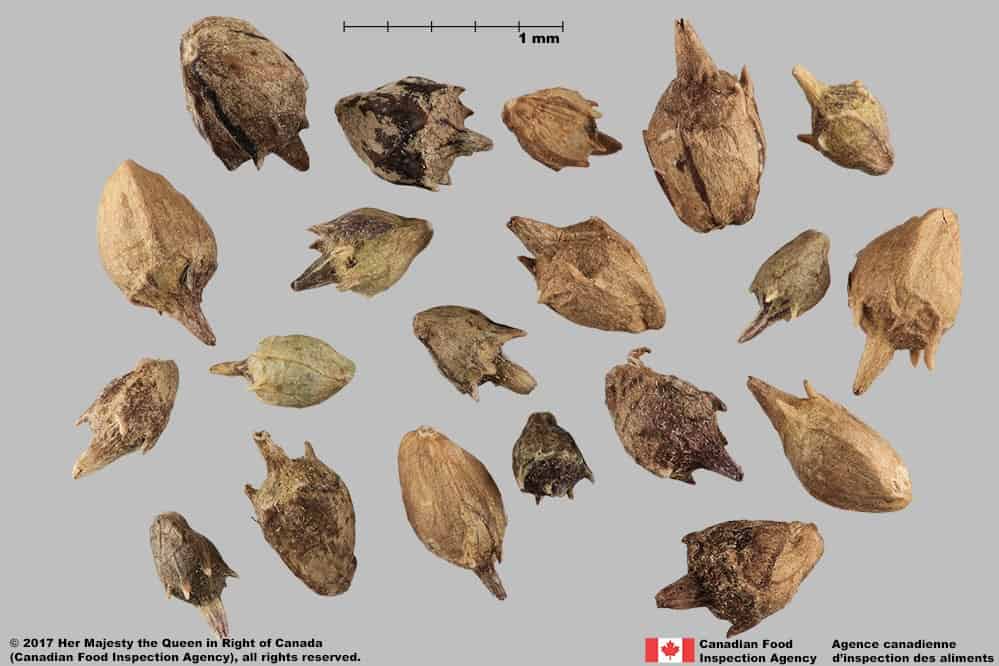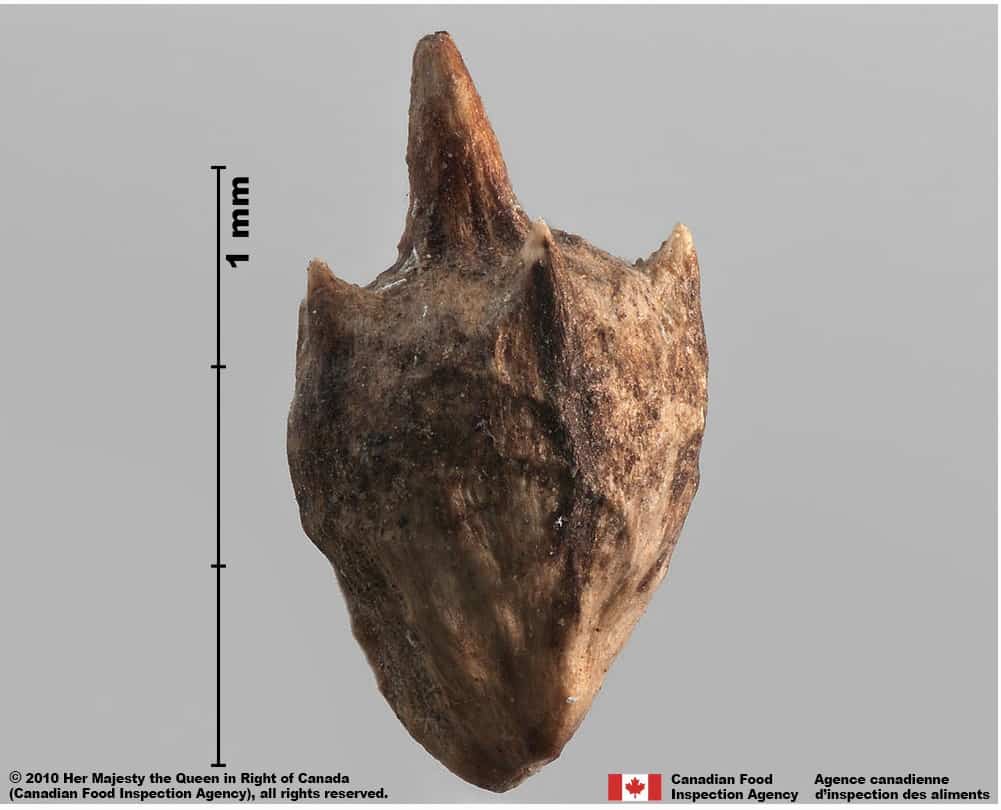Ambrosia trifida
Explore More :
Explore plus :
Overview
Aperçu
Regulation :
Remarques Réglementation:
- CFIA Weed Seeds Order - Class 2: Primary Noxious Weed Seeds
- Quarantine lists of countries e.g. India *may be updated without notice
Regulation Notes:
Distribution :
Répartition :
Native to North America and introduced to Asia (China, Georgia, Israel, Japan) and Europe (USDA-ARS 2020). Occurs in most of Canada, except Nunavut and Yukon territories, and reported as ephemeral in British Columbia (Brouillet et al. 2010+).
Habitat and Crop Association :
Habitat et Cultures Associées :
Ambrosia trifida likely occupied riparian habitats before widespread cultivation, and now occupies mesic soils in old fields, field margins, pastures, gardens, fencerows, shores, roadsides, railway lines, and other disturbed areas (Bassett and Crompton 1982; Montagnani et al. 2017). It is a weed of many broadleaved crops, especially Zea mays (corn), Glycine max (soybean) and Gossypium hirsutum (cotton) (Montagnani et al. 2017).
Economic Use, cultivation area, and Weed Association :
Utilisation économique, zone de culture et association de mauvaises herbes :
Duration of Life Cycle :
Durée du cycle vital:
Annual
Dispersal Unit Type :
Type d’unité de dispersion :
Bur
General Information
RENSEIGNEMENTS GÉNÉRAUX
One Ambrosia trifida plant generally produces a few hundred burs that are heavy with no obvious dispersal mechanisms (Bassett and Crompton 1982). Movement of burs after dispersal can occur through Lumbricus terrestris (earthworm) activity (Regnier et al. 2008), contaminated seed, wool processing, agricultural transport or periodic flooding (Montagnani et al. 2017).
A. trifida is an aggressive weed of grain crops and no-tillage fields (Regnier et al. 2008). Copious pollen production is a major cause of late summer hay fever, due to allergenic compounds and spine-covered grains (Bassett and Crompton 1982).
.
Ambrosia trifida infestation (Ohio State Weed Lab, The Ohio State University, Bugwood.org)
Identification
Identification
-
Bur
Size
- Bur length*: 4.1-7.7 mm (not including apical spike); width: 2.3 -6.1 mm
*Note: minimum and maximum of 20 burs in a normal range of this species using image measurement (ISMA 2020)
Shape
- Wedge-shaped burs with large spikes at the wide end, angular in 3 dimensions
Surface Texture
- Burs are smooth textured, with 5 longitudinal ribs, transverse wrinkles between ribs
Colour
- Burs dull straw-yellow, greyish-brown, yellowish-brown or brown
Other Features
- Each of the bur ribs ends in a spike at the wide end of the bur, and they surround a central spike (length*: 1.8 – 2.5 mm)
*Note: minimum and maximum of 10 burs in a normal range of this species using specimen measurement (ISMA 2020)

Giant ragweed (Ambrosia trifida) burs



-
Achene
Size
- Fills the bur, similar to bur size
Shape
- Achene is teardrop-shaped
Surface Texture
- Achene is smooth
Colour
- Achene is grey
Other Features
- Achene wall is thin and easily broken

Giant ragweed (Ambrosia trifida) bur, longitudinal section

-
Seed
Size
- Seed size similar to achene size
Shape
- Seed is teardrop-shaped
Surface Texture
- Seed is smooth
Colour
- Seed is orange
Other Features
- Seed coat thin and transparent
-
Embryo
Size
- The embryo fills the seed
Shape
- Embryo is spatulate, axial position
Endosperm
- Endosperm absent, nutritive tissue stored in the cotyledons
Other Features
- Cotyledons are fleshy and soft-textured
Identification Tips
CONSEILS POUR L’IDENTIFICATION
The burs of Ambrosia species can be distinguished by their relative size and spines or spikes at one end. A. trifida burs are the largest of the genus having spikes at one end with flared bases. Other species have smaller burs, with smaller spines and thinner bur layer. The achene and seed of A. trifida is fragile and rarely seen as the thick bur is not easily broken open.
Additional Botany Information
AUTRES RENSEIGNEMENTS BOTANIQUES
Flowers/Inflorescence
- 3-35 staminate flowers are clustered into disc-shaped heads on flowering stalks, 1-3 pistillate flowers are clustered at the base of the staminate stalks (Bassett and Crompton 1982)
Vegetative Features
- The involucral bracts surrounding the female flowers fuse together and harden, becoming a spiny bur enclosing the achene at maturity (FNA 1993+)

Ambrosia trifida plant (Theodore Webster, USDA Agricultural Research Service, Bugwood.org)



Similar Species
ESPÈCES SEMBLABLES
Similar species are based on a study of seed morphology of various species, and those with similar dispersal units are identified. The study is limited by physical specimen and literature availability at the time of examination, and possibly impacted by the subjectivity of the authors based on their knowledge and experience. Providing similar species information for seed identification is to make users aware of similarities that could possibly result in misidentification.
Ambrosia artemisiifolia L. (common ragweed)
A. artemisiifolia burs are smaller (length*: 1.9 – 3.7 mm; width: 1.5 – 2.8 mm), darker coloured, have smaller spines and a thinner bur wall than A. trifida.
*Note: minimum and maximum of 20 burs in a normal range of this species using image measurement (ISMA 2020)
Click to select species
Cliquez pour sélectionner les espèces

Ambrosia artemisiifolia
Comparison Window
Fenêtre de comparaison
MAIN SPECIES
ESPÈCES PRINCIPALES
Ambrosia trifida

Ambrosia trifida
Asteraceae
Giant ragweed (Ambrosia trifida) burs
MAIN SPECIES
ESPÈCES PRINCIPALES
Ambrosia trifida

Ambrosia trifida
Asteraceae
Giant ragweed (Ambrosia trifida) burs
MAIN SPECIES
ESPÈCES PRINCIPALES
Ambrosia trifida

Ambrosia trifida
Asteraceae
Giant ragweed (Ambrosia trifida) bur
MAIN SPECIES
ESPÈCES PRINCIPALES
Ambrosia trifida

Ambrosia trifida
Asteraceae
Giant ragweed (Ambrosia trifida) bur
SIMILAR SPECIES
ESPÈCES SEMBLABLES
Ambrosia artemisiifolia

Ambrosia artemisiifolia
Asteraceae
Common ragweed (Ambrosia artemisiifolia) burs
SIMILAR SPECIES
ESPÈCES SEMBLABLES
Ambrosia artemisiifolia

Ambrosia artemisiifolia
Asteraceae
Common ragweed (Ambrosia artemisiifolia) burs and one seed
SIMILAR SPECIES
ESPÈCES SEMBLABLES
Ambrosia artemisiifolia

Ambrosia artemisiifolia
Asteraceae
Common ragweed (Ambrosia artemisiifolia) bur
Need ID Help?
Besoin d’aide pour l’identification?
Reference(s)
Référence(s)
Bassett, I. J. and Crompton, C. W. 1982. The biology of Canadian weeds. 55. Ambrosia trifida L. Canadian Journal of Plant Science. 62: 1003-1010.
Brouillet, L., Coursol, F., Meades, S. J., Favreau, M., Anions, M., Bélisle, P. and Desmet, P. 2010+. VASCAN, the database of vascular plants of Canada. http://data.canadensys.net/vascan/ Accessed October 15, 2020.
Centre for Agriculture and Bioscience International (CABI). 2020. Invasive Species Compendium, CAB International, Wallingford, UK. https://www.cabidigitallibrary.org/journal/cabicompendium Accessed October 19, 2020.
Flora of North America (FNA) Editorial Committee, eds. 1993+. Flora of North America North of Mexico [Online]. 22+ vols. New York and Oxford. http://beta.floranorthamerica.org. Accessed December 29, 2022.
Global Biodiversity Information Facility (GBIF) Secretariat. 2022. https://doi.org/10.15468/39omei Accessed via https://www.gbif.org/species/3110588 Accessed December 29, 2022.
Government of Canada (GC). 2016. Canadian Weed Seeds Order. https://laws-lois.justice.gc.ca/eng/regulations/SOR-2016-93/page-2.html (English) https://laws-lois.justice.gc.ca/fra/reglements/DORS-2016-93/page-2.html (French)
International Seed Morphology Association (ISMA). 2020. Method for Seed Size Measurement. Version 1.0. ISMA Publication Guide. https://www.idseed.org/authors/details/method_for_seed_size_measurement.html
Montagnani C., R. Gentili, M. Smith, M. F. Guarino and S. Citterio. 2017. The worldwide spread, success, and impact of ragweed (Ambrosia spp.). Critical Reviews in Plant Sciences 36: 139-178.
Regnier, E., Harrison, S. K., Liu, J., Schmoll, J. T., Edwards, C. A., Arancon, N. and Holloman, C. I. 2008. Impact of an exotic earthworm on seed dispersal of an indigenous US weed. Journal of Applied Ecology 45 (6).
U.S. Department of Agriculture-Agricultural Research Services (USDA-ARS). 2020. Germplasm Resources Information Network (GRIN), https://npgsweb.ars-grin.gov/gringlobal/taxon/taxonomysimple.aspx Accessed October 13, 2020.




